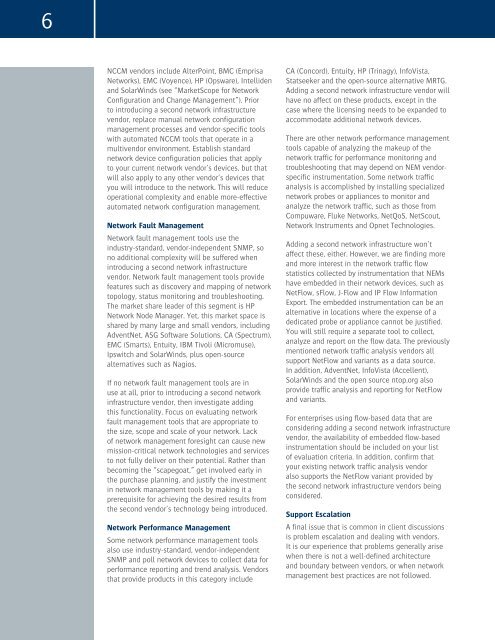#1 Network Contender - GovConnection
#1 Network Contender - GovConnection
#1 Network Contender - GovConnection
Create successful ePaper yourself
Turn your PDF publications into a flip-book with our unique Google optimized e-Paper software.
6<br />
NCCM vendors include AlterPoint, BMC (Emprisa<br />
<strong>Network</strong>s), EMC (Voyence), HP (Opsware), Intelliden<br />
and SolarWinds (see “MarketScope for <strong>Network</strong><br />
Configuration and Change Management”). Prior<br />
to introducing a second network infrastructure<br />
vendor, replace manual network configuration<br />
management processes and vendor-specific tools<br />
with automated NCCM tools that operate in a<br />
multivendor environment. Establish standard<br />
network device configuration policies that apply<br />
to your current network vendor’s devices, but that<br />
will also apply to any other vendor’s devices that<br />
you will introduce to the network. This will reduce<br />
operational complexity and enable more-effective<br />
automated network configuration management.<br />
<strong>Network</strong> Fault Management<br />
<strong>Network</strong> fault management tools use the<br />
industry-standard, vendor-independent SNMP, so<br />
no additional complexity will be suffered when<br />
introducing a second network infrastructure<br />
vendor. <strong>Network</strong> fault management tools provide<br />
features such as discovery and mapping of network<br />
topology, status monitoring and troubleshooting.<br />
The market share leader of this segment is HP<br />
<strong>Network</strong> Node Manager. Yet, this market space is<br />
shared by many large and small vendors, including<br />
AdventNet, ASG Software Solutions, CA (Spectrum),<br />
EMC (Smarts), Entuity, IBM Tivoli (Micromuse),<br />
Ipswitch and SolarWinds, plus open-source<br />
alternatives such as Nagios.<br />
If no network fault management tools are in<br />
use at all, prior to introducing a second network<br />
infrastructure vendor, then investigate adding<br />
this functionality. Focus on evaluating network<br />
fault management tools that are appropriate to<br />
the size, scope and scale of your network. Lack<br />
of network management foresight can cause new<br />
mission-critical network technologies and services<br />
to not fully deliver on their potential. Rather than<br />
becoming the “scapegoat,” get involved early in<br />
the purchase planning, and justify the investment<br />
in network management tools by making it a<br />
prerequisite for achieving the desired results from<br />
the second vendor’s technology being introduced.<br />
<strong>Network</strong> Performance Management<br />
Some network performance management tools<br />
also use industry-standard, vendor-independent<br />
SNMP and poll network devices to collect data for<br />
performance reporting and trend analysis. Vendors<br />
that provide products in this category include<br />
CA (Concord), Entuity, HP (Trinagy), InfoVista,<br />
Statseeker and the open-source alternative MRTG.<br />
Adding a second network infrastructure vendor will<br />
have no affect on these products, except in the<br />
case where the licensing needs to be expanded to<br />
accommodate additional network devices.<br />
There are other network performance management<br />
tools capable of analyzing the makeup of the<br />
network traffic for performance monitoring and<br />
troubleshooting that may depend on NEM vendorspecific<br />
instrumentation. Some network traffic<br />
analysis is accomplished by installing specialized<br />
network probes or appliances to monitor and<br />
analyze the network traffic, such as those from<br />
Compuware, Fluke <strong>Network</strong>s, NetQoS, NetScout,<br />
<strong>Network</strong> Instruments and Opnet Technologies.<br />
Adding a second network infrastructure won’t<br />
affect these, either. However, we are finding more<br />
and more interest in the network traffic flow<br />
statistics collected by instrumentation that NEMs<br />
have embedded in their network devices, such as<br />
NetFlow, sFlow, J-Flow and IP Flow Information<br />
Export. The embedded instrumentation can be an<br />
alternative in locations where the expense of a<br />
dedicated probe or appliance cannot be justified.<br />
You will still require a separate tool to collect,<br />
analyze and report on the flow data. The previously<br />
mentioned network traffic analysis vendors all<br />
support NetFlow and variants as a data source.<br />
In addition, AdventNet, InfoVista (Accellent),<br />
SolarWinds and the open source ntop.org also<br />
provide traffic analysis and reporting for NetFlow<br />
and variants.<br />
For enterprises using flow-based data that are<br />
considering adding a second network infrastructure<br />
vendor, the availability of embedded flow-based<br />
instrumentation should be included on your list<br />
of evaluation criteria. In addition, confirm that<br />
your existing network traffic analysis vendor<br />
also supports the NetFlow variant provided by<br />
the second network infrastructure vendors being<br />
considered.<br />
Support Escalation<br />
A final issue that is common in client discussions<br />
is problem escalation and dealing with vendors.<br />
It is our experience that problems generally arise<br />
when there is not a well-defined architecture<br />
and boundary between vendors, or when network<br />
management best practices are not followed.


